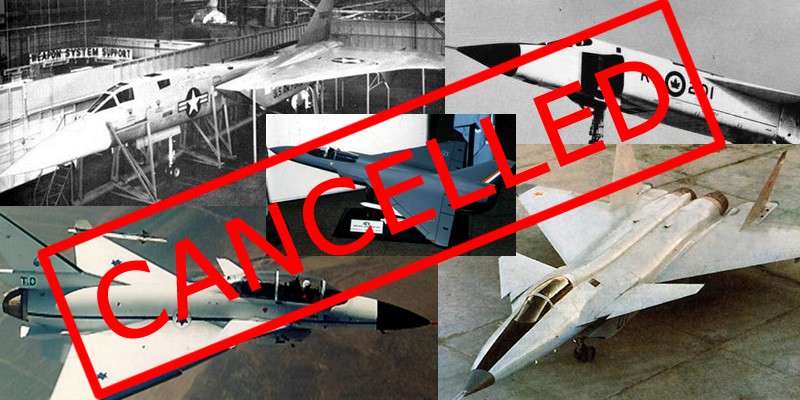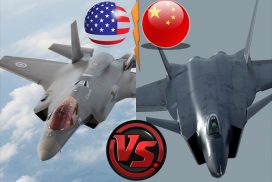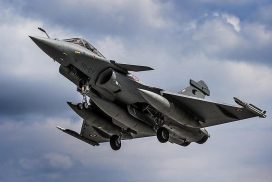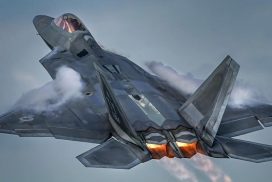Every combat aircraft is designed and built to serve a specific purpose. But sometimes, a combat aircraft program may lose it’s purpose midway due to a number of factors such as budget cuts, political pressure and technological obsolescence. This means that the program no longer warrants the same attention that it did during its conception and becomes redundant. Whatever be the reason, when a program is cancelled, it leaves behind some “stillborn aircraft” and also raises a number of “what ifs”. The intrigue these cancelled programs present, fascinate people to this day. Here are the top 5 cancelled fighter plane programs.
1. North American XF-108 Rapier

The XF-108 Rapier was designed by the North American Aviation Company in direct response to the ever increasing fleet of Soviet bombers. Though the North American Aviation Company had some very successful aircraft from its stable like the P-51, F-86, B-26 and the T-6, this revolutionary aircraft was to be the company’s last.
In the early 1950s, the USAF conducted studies and found that the greatest threat to Continental USA was from the new nuclear capable, high speed Soviet bombers. The USAF concluded that the only effective way to combat this threat was to use high speed interceptor aircraft to intercept these bombers before they could get close to the American mainland. Though the F-102 Delta Dagger was already in service with the USAF, it lacked the range to be able to intercept Soviet bombers far from the mainland.
The specifications put forward by the USAF on the 6th of October, 1955 included an interceptor capable of flying at an altitude of 60,000 feet, with a speed of Mach 1.7 and a range of 1,000 miles.
Though the industry’s giants lunged at the offer, North American Aviation’s proposal piqued the USAF’s interest the most. Their concept for the F 108’s design included a large “cranked delta” wing and a very large and heavy fuselage. This huge interceptor was powered by two massive General Electric YJ93-GE-3AR turbojet engines, each of which output an impressive 29,300 lbf of thrust. This meant that it could reach speeds of Mach 3and maintain a combat radius of well over 1,000 miles. It also carried 3 Hughes GAR 9A air to air missiles to intercept bombers.
Even though the aircraft sounded great on paper, it was simply too expensive for the USAF to procure and operate. The new budget coupled with the fact that the Soviets were changing their aerial attack strategy from bombers to ICBMs meant that the plug on the XF 108 Rapier had to be pulled quietly and unceremoniously. Thus like so many cold war projects, the XF 108 Rapier program died quietly.
Specifications
Crew: two
Length: 89.2 ft (27.2 m)
Wingspan: 57.4 ft (17.5 m)
Height: 22.1 ft (6.7 m)
Wing area: 1,865 ft² (173.4 m²)
Powerplant: 2 × General Electric YJ93-GE-3AR afterburning turbojet
Dry thrust: 20,900 lbf (93.0 kN) each
Thrust with reheat: 29,300 lbf (130.3 kN) each
Maximum speed: Mach 3+, 1,980 mph (1,720 kn, 3,190 km/h)
Range: 1,271 mi (1,104 nmi, 2,033 km) combat
Armament
Guns: 4 x 20 mm cannon
Missiles: 3 × Hughes GAR-9A air-to-air missiles in a rotary weapons bay
Bombs: 4,000 lbs
2. Avro Canada CF-105 Arrow
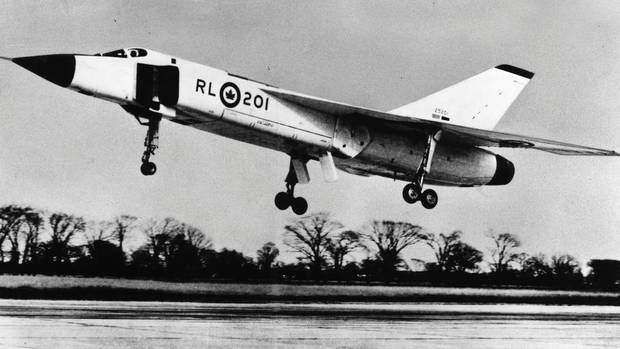
A cause of both national pride and intrigue, the infamous Avro Arrow is probably the most controversial aircraft on the list. It is also the only aircraft on the list to have a dedicated TV miniseries.
The Avro Arrow was designed and built by the Avro Canada Company in the mid 1950s, based on studies done by the Canadian military. Like their American counterparts, the Canadian military concluded from their studies that the Soviets were most likely to attack the North American mainland by flying over the Arctic using high speed and high altitude bombers. The most effective way to combat this threat was to develop interceptors that could intercept Soviet bombers before they could get close to the North American mainland. Therefore, when it came to performance characteristics, speed, climb rate and range were of highest priority while maneuverability took a back seat.
During the initial stages of the Cold War, Canada emerged as a major player in the aerospace industry, capable of mass producing aircraft such as the Canadair F- 86 and the Avro Canada CF-100 Canuck.
In the early 1950s, Canada found its Air Force without a supersonic interceptor. Meanwhile, the engineers at Avro Canada were fresh from the failed CF-103 program. Though the CF-103 program was a failure, Canadian scientists and engineers had gained valuable experience from it. This led to the design of the Avro Arrow. Like many interceptors of the time period, this aircraft had large, delta wings and two powerful engines. In this case, the powerplants were also supposed to be the Canadian built Orenda Iroquois Series II turbojet engines. The aircraft was almost one hundred percent Canadian and was seen as the epitome of the Canadian aerospace industry, until the sudden cancellation of the program on the 20th of February, 1959 by Prime Minister Diefenbaker. The sudden cancellation of an otherwise successful program sent shockwaves through the industry. The Prime Minister’s next move was even more outrageous. The six prototype aircraft and their blueprints were to be cut up and destroyed. Though official reports claim that all prototypes and related equipment were destroyed, unofficial reports say that one example of the Avro Arrow was secretly flown to the RAF Manston air base, in the UK.
So, why was a successful program suddenly terminated? According to one explanation, the entire Avro facility in Canada at that point of time was completely infiltrated by KGB agents and Prime Minister Diefenbaker made the call to destroy all traces of the Arrow program to prevent cutting edge technology from being compromised.
Conspiracy or fact? The Canadian government hasn’t really cleared the air since the Arrow program and it’s this intrigue that fascinates so many people to this day.
Specifications
Crew: 2
Length: 77 ft 9 in (23.71 m)
Wingspan: 50 ft 0 in (15.24 m)
Height: 21 ft 2 in (6.25 m)
Powerplant: 2 × Pratt & Whitney J75-P-3turbojets
Dry thrust: 12,500 lbf (55.6 kN) each
Thrust with afterburner: 23,500 lbf (104.53 kN) each
Maximum speed: Mach 1.98 (1,307 mph, 2,104 km/h) at 50,000 ft (15,000 m) max. Recorded speed; Mach 2+ potential
Cruise speed: Mach 0.91 (607 mph, 977 km/h) at 36,000 ft (11,000 m)
Combat radius: 360 NM (410 mi, 660 km)
Armament
Rockets: 1–4× AIR-2 Genie unguided nuclear rockets (or)
Missiles: Up to 8× AIM-4 Falcon, Canadair Velvet Glove (cancelled in 1956) or 3 AIM-7 Sparrow II 2D active guidance missiles (cancelled)
3. IAI Lavi

Until the six day war of 1967, the Israeli Air Force constituted of primarily French aircraft. However, after the war, France refused to deliver the new Mirage 5J aircraft that Israel had ordered and payed for. The Israelis were furious and felt betrayed by the French. They later outsmarted the French by secretly obtaining the blueprints of the Mirage 5 and built the IAI Nesher from these blueprints. Though the Israelis overcame the odds, they soon realized that the only people who they could depend on were themselves. Therefore they set upon a program to build a small and highly maneuverable aircraft that could be equipped with state of the art electronics.
When the first prototype was unveiled in 1985, the resemblance it bore to the F-16, which was already in service with the Israeli Air Force was striking. It almost seemed like the Lavi was a smaller and tubbier version of the F -16. The main difference between the F-16 and the Lavi was the wing layout. The Lavi had a canard-delta tailess wing layout which made it look like the love child of an F-16 and a Saab Gripen. This made the aircraft inherently unstable, but the presence of quadruplex fly by wire meant that most of the strain was taken off the pilot.
Though the IAI Lavi was initially fitted with the GE404 turbofan engine, pilots found the aircraft to be underpowered. The Israelis later swapped out the GE404 for the more powerful PW1120 turbofan engine, which output 20,600 lbf of thrust.
While the aerodynamics of the aircraft was impressive, what seemed to be the Lavi’s biggest asset was the state of the art software and electronics. Right from the cockpit layout, to the HUD, to the mission computer, in this regard the aircraft was cutting edge.
Though almost 40% of the Lavi program was funded by the USA, the Americans had started prohibiting the export of cutting edge technology to Israel because they feared that the IAI Lavi would be direct competition for American fighter aircraft such as the F-16, on the international market. To make matters worse, Israel suffered a massive economic depression in the spring of 1985, which ultimately sounded the death knell of the Lavi program.
Specifications
Crew: 1
Length: 14.57 m (47 ft 10 in)
Wingspan: 8.78 m (28 ft 10 in)
Height: 4.78 m (15 ft 8 in)
Wing area: 33.0 m² (355 ft²)
Powerplant: 1 × Pratt & Whitney PW1120 afterburning turbofan, 91.5 kN (20,600 lbf)
Maximum speed: 1,965 km/h / Mach 1.6 (1,220 mph)
Range: 3,700 km (2,300 mi)
Armament
1 × 30 mm DEFA cannon
7,260 kg (16,000 lb) of stores
4. Atlas Carver

The Atlas Carver program, sometimes referred to as the “CAVA program”, was a South African program led by the Atlas Aircraft Corporation, in a bid to replace the South African Air Force’s fleet of obsolete, vintage aircraft. Like the Israelis, the South Africans used a large number of French aircraft during the 60s, and a number of efforts were taken to keep the existing aircraft in service with a number of upgrades. Though these upgrades were nothing short of impressive, the service life of the aircraft could only be stretched so much.
During the late 80s, the South African Air Force found their fleet strength to be falling rapidly both in terms of quality and quantity. The South African government’s firm stance on apartheid meant that South African military planners knew that the UN arms embargo on the nation was there to stay and understood that the only way out, was through a more local solution.
Though the Atlas Cheetah program was considered to be a success, it was merely an elaborate up-gradation program and not an independent fighter program. Therefore, when the Atlas Aircraft Corporation was tasked with developing the new fighter, some serious problems became immediately apparent. South Africa’s access to advanced technology was severely limited by the UN arms embargo and their only option was to enlist foreign help to get the project off the ground.
The South Africans turned to the Israelis, who were ironing out the kinks in their very own “Lavi” program at the time. Some Israeli scientists and engineers did offer their services to the South Africans, who in turn payed top dollar for their efforts.
By early 1991, the South African government had spent nearly $2 billion on the Carver program. The South African economy wasn’t exactly sitting pretty and some leaders began questioning the feasibility of the entire program. This caused the program to be put on the back burner. Meanwhile, apartheid had been abolished, Mr. Mandela became the president and South Africa was experiencing a revolution. Now what this meant was that the UN arms embargo was lifted and South Africa was free to buy arms off the international market. Keeping this in mind, the new government felt that the need for an expensive fighter program wasn’t top priority for the recovering South African economy.
The Carver program was a rather interesting fighter program, born out of desperation and forced into oblivion, primarily because of political and economical reasons.
Specifications
Crew: 1
Length: 15.06m (49ft 5 in)
Wingspan: N/A
Height: N/A
Wing Area: N/A
Powerplant: Powerplant: 1 × SNECMA Atar 09C turbojet
Dry thrust: 41.97 kN (9,436 lbf)
Thrust with afterburner: 60.80 kN (13,668 lbf)
Maximum speed: Mach 2 (2,350 km/h, 1,268 knots, 1,460 mph) at 12,000 m (39,370 ft)
Armament: N/A
5. Mikoyan Project 1.44/1.42
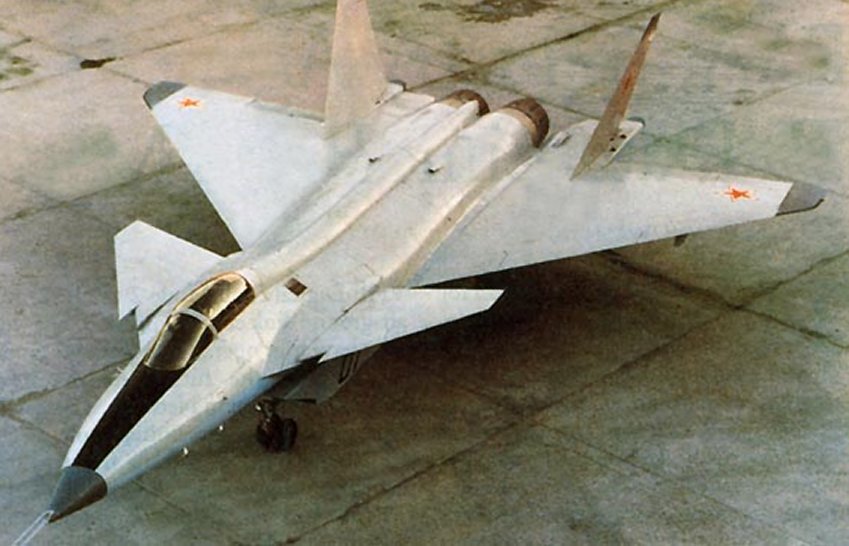
The 80s were a very interesting time for fighter aircraft because it saw the introduction of a lot of new technology. One such advancement that the Americans and the Soviets were working towards was stealth. Though stealth is a very commonly used word in the aerospace industry today, back in the 80s, it was all hush hush.
The Americans got a head-start on the new generation of stealthy aircraft, with the “Advanced Tactical Fighter” or the ATF. When the Soviets realized how much they lagged behind the Americans in this regard, they were eager to get back into the game and doubled their efforts on the new generation aircraft.
Some of the prerequisites of the program included super-maneuverability, super-cruise and stealth. In order to catch up with the west, the Soviets launched two programs simultaneously. A large, heavy fighter and a smaller, more maneuverable fighter were to be designed. The aircraft of both programs were to have a number of shared components to reduce costs, in typical Soviet fashion.
The Sukhoi Design Bureau went about designing the heavy SU-47 “Berkut”, the RAC-Mikoyan Bureau was tasked with designing the lighter MIG MFI (Multirole Frontline Fighter). The program was progressing at a steady pace, only to be shelved with the fall of the Soviet Union. The heavy economic burden carried by the Russian Federation post USSR breakup meant that the MIG MFI program didn’t have the funds necessary for its continued development.
The cold war had come back to claim it’s last victim.
However, this story has a silver lining. Though work on the project has stopped, the Russian government hasn’t cancelled the program yet. This means that the project is simply dormant and could be reactivated if needed. But with the introduction of the Sukhoi PAK FA, the reactivation of the MIG 1.44/1.42 seems rather unlikely.
Specifications
Crew: 1
Length: 19 m (63 ft)
Wingspan: 15 m (50 ft)
Height: 4.50 m (15 ft)
Powerplant: 2 × Lyulka AL-41F afterburning turbofans, 176 kN (39,680 lb) each
Maximum speed: Mach 2. (2,760 km/h, 1,725 mph)
Range: 4,000 km (2,500 mi)
Service ceiling: 21,555 m (70,720 ft)
Armament
Guns: 1× 30 mm Izhmash GSh-301 cannon, 250 rounds
Missiles: R-77 (AA-12 Adder) medium-range radar-guided missiles, R-73 (AA-11 Archer) short-range IR-guided missiles, K-37 long-range radar-guided missiles, K-74 short-range IR-guided missiles
Payload: likely any AGM or small-diameter free fall bomb in the Russian inventory

